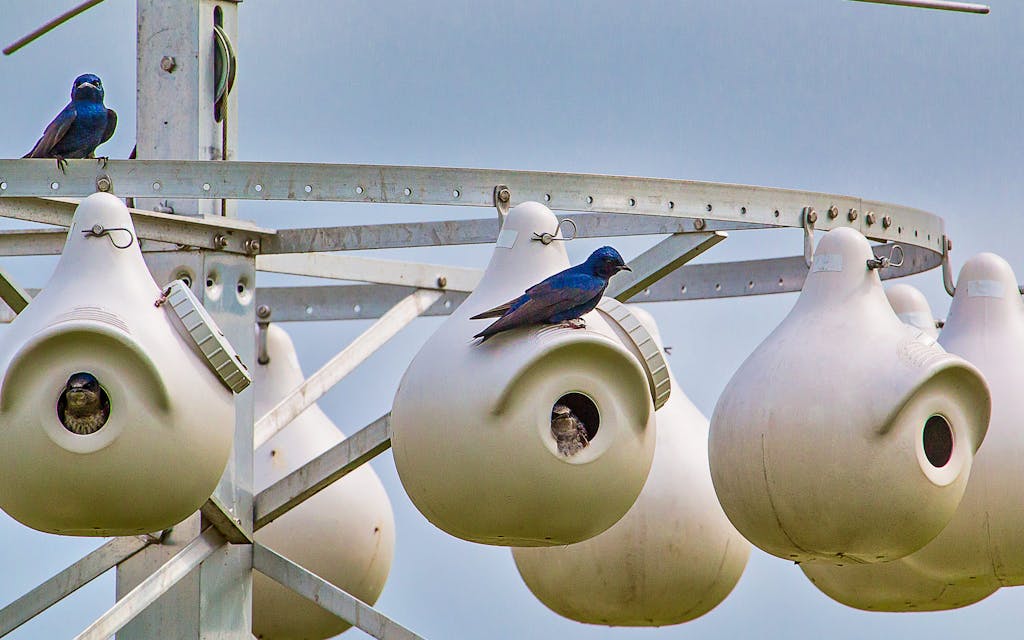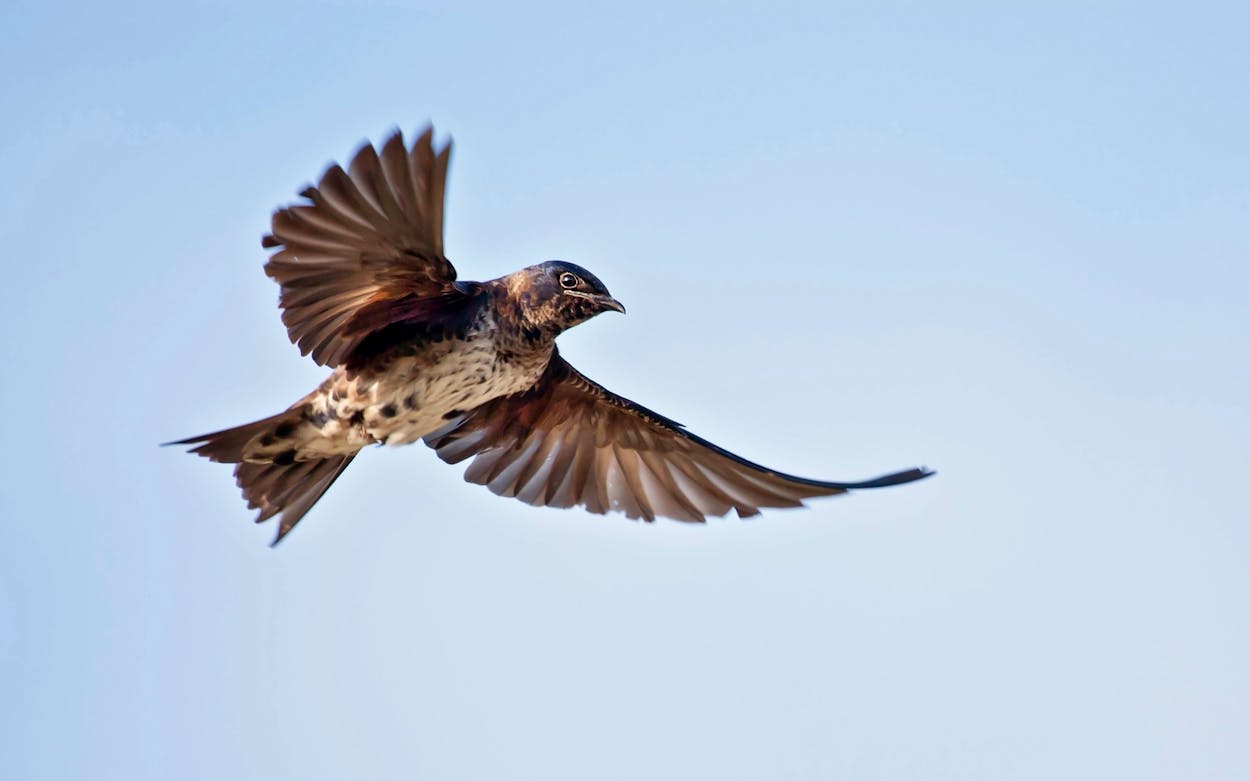In 1990, wildlife biologist Jim Ray was attending South Dakota State University to complete his master’s degree when he saw the bird that would shape the rest of his life. Ray was visiting a college buddy who had installed a martin house: a birdhouse that’s mounted on a pole and sometimes resembles a gourd or miniaturized apartment building. The backyard structure was inhabited by purple martins, a flashy and personable member of the swallow family known for gathering in large numbers and performing extreme aerial acrobatics. “I couldn’t take my eyes off them,” Ray remembers. “The purple martin feeds high up in the air, way higher than other swallows. Then they will fold their wings, and in one swoop, they drop into their cavity. When I saw that, I was hooked.”
Ray isn’t alone in his infatuation with the purple martin, a native bird that makes its entrance into North America each spring from its wintering grounds in South America. Inhabiting most of Texas (with the exceptions of part of the Panhandle and West Texas), the species nests exclusively in human-made structures. It’s one of the only birds to do so. A network of martin fans in Texas, including Ray, maintain accommodations for the creatures on public or private properties. They call themselves “landlords” because, along with installing housing, they must maintain the properties and protect them from predators. Good bird landlords can look forward to inviting the same martins back home each spring. For Ray, who watches some three hundred chicks fledge per year on his property in Amarillo, keeping the birds happy is of utmost importance. “When my wife and I built our house out here, I decided where the house would sit based on it not interfering with the martin houses,” he says.
The first purple martins returning to Texas each year arrive in the Rio Grande Valley as early as late January. By the end of March, martins will have distributed themselves throughout Texas. As they travel, martins feed and drink on the wing. They return to previously used nesting sites each year, a behavior known as “site fidelity,” says Mercedes Leofsky, a biologist and research manager with the Purple Martin Conservation Association. It’s one of the traits birders appreciate most about the critters. “They just love their martins and tend to get really attached to them, because you can count on those same birds coming back every year,” Leofsky says.
Some historical accounts indicate purple martins have been popular companion animals in North America since before Anglos showed up. The Choctaw and Chickasaw tribes hung hollowed-out gourds to attract martins to their villages, perhaps in part for practical reasons—martins tend to alert their landlords with zwrack and zweet calls if they spot a predator or a stranger. Martins are also expert hunters of flies, wasps, mosquitoes, and other pesky arthropods, so their presence would have made village life more tolerable. The lives of humans and purple martins are now so intertwined that the species would likely not survive if humans stopped providing nesting structures.
An estimated seven million martins live in the wild today. But their numbers have been in a slow decline for years, experts say, likely due to environmental mercury contamination and habitat loss, among other factors. The polar vortex that struck Texas in February 2021 was a death sentence for the early arrivals to Texas and Louisiana that year, Leofsky says. The purple martin is now considered a Watch List species by the American Bird Conservancy, meaning it is a species of “special concern” in many U.S. states and Canada. Data submitted to the citizen-science website eBird.org from 2007 to 2021 show a precipitous decline in Texas martin sightings, especially along the Gulf Coast and in East Texas.
In recent years, scientists have worked to precisely track martin movements in the hopes that data will shed more light on what the birds do domestically and internationally. Ray, the wildlife biologist, equipped purple martins with GPS-enabled backpacks as part of a wide-ranging study on the species’s migratory patterns. The research revealed that subadults—a.k.a. birds that have not raised chicks before—usually returned to live within twenty-mile radii of their birth nests; it also showed that martins use the Yucatán Peninsula, in southeast Mexico, as a stopover site for several weeks during their migrations. “It’s accurate down to the roost tree,” Ray says. Hopefully the data will help conservation efforts for the species in South America, where less is known about the perils martins face.
The martins’ woes are compounded by another troubling trend: the once-popular pastime of martin keeping hasn’t exactly caught on with the younger crowd. Not everyone has the heart to do the dirty work that’s required to keep martins safe—which can include physically removing other birds, eggs, and nesting material from houses. Ray says that keeping invasive house sparrows away from his martin houses is “like World War III” some days. A participant included in a 2019 review of landlords put it this way: “You have to have almost a cruel streak in you to be a successful martin landlord.”

Few landlords are as dedicated as Andy and Julia Balinsky, who practically run a full-service avian bed and breakfast. The Balinskys manage two colonies in Austin, one at Patterson Park, in Central Austin, and another at Hornsby Bend Biosolids Management Facility, which doubles as an environmental education center. The commitment they show their tenants is unrivaled. Once, during a late cold snap that kept the insects from flying in May, the Balinskys donned cold-weather gear and delivered mealworms to new hatchlings that would have starved otherwise. Last summer, they even soaked crickets in homemade “electrolyte fluid” and hand-fed them to the babies. “It was the coolest thing ever,” Julia says. “With no other bird in the whole wide world could you do this. And this isn’t for everybody, but it’s pretty great for us.”
In the summer, the Balinskys’ call to duty grows even louder. That’s when purple martins across Texas begin to leave their nests and converge at megaroosts that can comprise 200,000 individuals. In the Austin area, roosts have variously been found at the former Highland Mall and Round Rock’s La Frontera Village. Once they’ve settled on a spot, the birds will flit and flap in a spectacular performance that draws crowds of onlookers. Similar spectacles play out in Dallas, Houston, and other Texas cities as the martins prepare to turn tail and travel back to South America each year.
With so many birds roosting at once, inevitably some problems crop up. Some martins collide with windows. Some are attacked by raccoons or feral cats. (“We didn’t do all that work just to raise cat food,” Andy says.) Sometimes property owners are less than thrilled about the prospect of housing thousands of birds for a couple months. The Balinskys work as de facto diplomats on the martins’ behalf, striking deals with property managers for the birds’ safe passage. One such meeting with an Embassy Suites hotel in Central Austin went better than expected: the hotel enthusiastically welcomed its newfound flock—a bartender even created a Purple Martini for the cocktail menu, Julia says.
And just like that, the martins made another friend. They’ve got a knack for that. So as spring turns to summer in the Lone Star State, keep your eyes on the skies for the purple martins. While you’re at it, consider opening up your heart—or at least your yard—to the birds. They might just make a friend of you too.
How to Be a Purple Martin Landlord
- The structure you use should be raised at least ten feet off the ground, have the ability to be removed for cleaning and eradicating pests, and be placed in a treeless area. If you build it, they will come. Usually, at least.
- If you’re having trouble attracting purple martins, some hopeful landlords have found success by playing martin songs at sunrise, Say Anything–style. Decoy birds can also help convince timid martins to stop by.
- If you have an existing house, block the entrances until martins return to the area in spring. This will deter house sparrows and European starlings from settling in first. Then open a few cavities at a time as more martins return in the following weeks.
- Grab a lawn chair, sit back, and get ready to bask in the purple martin splendor all season long.






